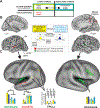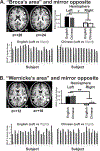Chinese-English bilinguals show linguistic-perceptual links in the brain associating short spoken phrases with corresponding real-world natural action sounds by semantic category
- PMID: 34568509
- PMCID: PMC8462789
- DOI: 10.1080/23273798.2021.1883073
Chinese-English bilinguals show linguistic-perceptual links in the brain associating short spoken phrases with corresponding real-world natural action sounds by semantic category
Abstract
Higher cognitive functions such as linguistic comprehension must ultimately relate to perceptual systems in the brain, though how and why this forms remains unclear. Different brain networks that mediate perception when hearing real-world natural sounds has recently been proposed to respect a taxonomic model of acoustic-semantic categories. Using functional magnetic resonance imaging (fMRI) with Chinese/English bilingual listeners, the present study explored whether reception of short spoken phrases, in both Chinese (Mandarin) and English, describing corresponding sound-producing events would engage overlapping brain regions at a semantic category level. The results revealed a double-dissociation of cortical regions that were preferential for representing knowledge of human versus environmental action events, whether conveyed through natural sounds or the corresponding spoken phrases depicted by either language. These findings of cortical hubs exhibiting linguistic-perceptual knowledge links at a semantic category level should help to advance neurocomputational models of the neurodevelopment of language systems.
Keywords: grounded cognition; hearing perception; natural language processing (Alternatives: second language, glottogenesis, fMRI); oral communication.
Figures



Similar articles
-
Hearing and orally mimicking different acoustic-semantic categories of natural sound engage distinct left hemisphere cortical regions.Brain Lang. 2018 Aug;183:64-78. doi: 10.1016/j.bandl.2018.05.002. Epub 2018 Jun 29. Brain Lang. 2018. PMID: 29966815 Free PMC article.
-
Auditory object perception: A neurobiological model and prospective review.Neuropsychologia. 2017 Oct;105:223-242. doi: 10.1016/j.neuropsychologia.2017.04.034. Epub 2017 Apr 30. Neuropsychologia. 2017. PMID: 28467888 Free PMC article. Review.
-
Divergent Human Cortical Regions for Processing Distinct Acoustic-Semantic Categories of Natural Sounds: Animal Action Sounds vs. Vocalizations.Front Neurosci. 2017 Jan 6;10:579. doi: 10.3389/fnins.2016.00579. eCollection 2016. Front Neurosci. 2017. PMID: 28111538 Free PMC article.
-
Brain-based translation: fMRI decoding of spoken words in bilinguals reveals language-independent semantic representations in anterior temporal lobe.J Neurosci. 2014 Jan 1;34(1):332-8. doi: 10.1523/JNEUROSCI.1302-13.2014. J Neurosci. 2014. PMID: 24381294 Free PMC article. Clinical Trial.
-
Syllable as a unit of information transfer in linguistic communication: The entropy syllable parsing model.Wiley Interdiscip Rev Cogn Sci. 2020 Jan;11(1):e1518. doi: 10.1002/wcs.1518. Epub 2019 Sep 10. Wiley Interdiscip Rev Cogn Sci. 2020. PMID: 31505710 Review.
References
-
- Aglioti S, Fabbro F, 1993. Paradoxical selective recovery in a bilingual aphasic following subcortical lesions. Neuroreport 4, 1359–1362. - PubMed
-
- Anderson AJ, Binder JR, Fernandino L, Humphries CJ, Conant LL, Aguilar M, Wang X, Doko D, Raizada RDS, 2017. Predicting Neural Activity Patterns Associated with Sentences Using a Neurobiologically Motivated Model of Semantic Representation. Cereb Cortex 27, 4379–4395. - PubMed
-
- Aziz-Zadeh L, Wilson SM, Rizzolatti G, Iacoboni M, 2006b. Congruent embodied representations for visually presented actions and linguistic phrases describing actions. Curr Biol 16, 1818–1823. - PubMed
-
- Barsalou LW, 2008. Grounded cognition. Annu Rev Psychol 59, 617–645. - PubMed
Grants and funding
LinkOut - more resources
Full Text Sources
